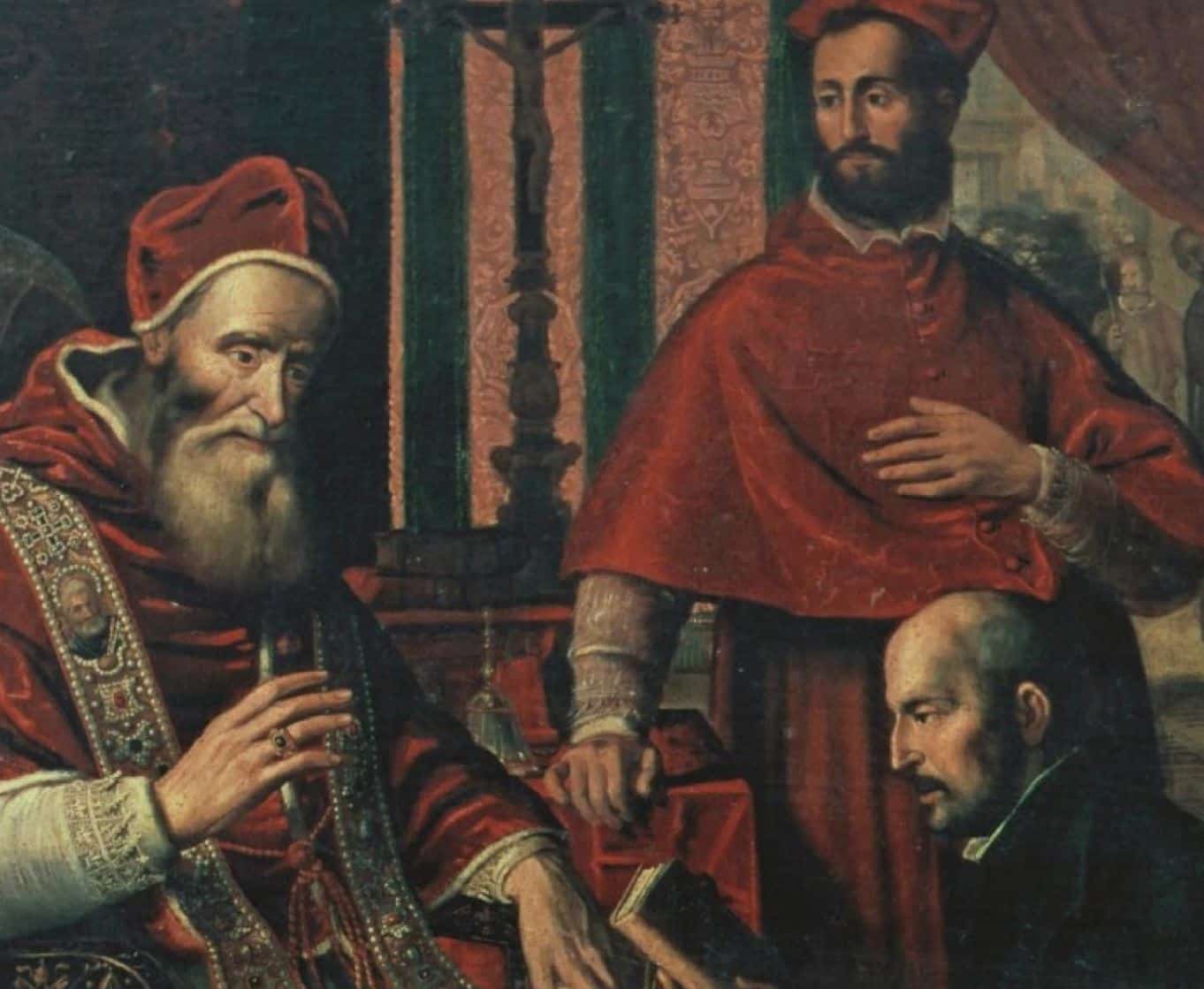In June 2017, I had the occasion to meet the eminent Jesuit historian Fr. John Padberg, who died just a few months ago at age 95. I was a Jesuit novice at the time, toward the beginning of my journey in religious life. Knowing Fr. Padberg was such an esteemed Jesuit figure, toward the end of our conversation I chose to ask him a fairly broad question: As a historian of the Society, and someone who’s seen decades of that history yourself, what advice do you have for a novice just getting started? He responded, “First, study Jesuit history! Second, don’t think that my generation or yours are saviors of the Society, or its downfall. We’re all part of a much, much larger story.”
This much, much larger story of the Society of Jesus is also the subject of a new (or, more precisely, newly available in English) history of the Jesuits by the German historian Markus Friedrich. Efficiently titled, The Jesuits: A History, Friedrich’s book certainly helped me live up to the first of Fr. Padberg’s pieces of advice. It also helps the reader to understand the sweep of Jesuit history from a new perspective. Readers who are familiar with Jesuits, or interested in Church history more broadly, stand to benefit from Friedrich’s book. It is impossible to understand the Jesuits today, or indeed much of the past four centuries of Church history, without understanding who the Jesuits are, how the order began, why it nearly ended, and why Jesuits have been held in both esteem and suspicion throughout their history.
At the beginning of his book, Friedrich addresses this novelty of his perspective: he is neither a Jesuit himself nor one of the (many) opponents the Society has picked up over the centuries. He finds that Jesuit historians have done good work, but are biased with a basic sympathy toward the Society of which they are members, whereas the Society’s opponents rarely do it justice as a subject. He wants to get beyond simple stereotypes some have used to label the Jesuits over the centuries, whether as arch-conservative defenders of the pope or as dangerous reformers. Rather, he sets out “to present the Jesuit order as an incredibly diverse institution, so as to contradict still current cliches about it. There neither was nor is the stereotypical Jesuit, and there neither was nor is the Society of Jesus, except in a legal and institutional sense” (17).
Friedrich devotes much of his early chapters to explaining the Society’s roots in St. Ignatius’ spiritual journey, his writings and principles, and the “way of proceeding” he instilled in the new order. He explains common Jesuit themes such as indifference, “finding God in all things,” the magis, striving for “the greater glory of God,” and the Jesuit’s role as one who “helps souls.” Quoting the early Jesuit leader Jeronimo Nadal, he describes the Jesuit as a “contemplative in action.” He notes just how novel this combination was for this upstart religious order: “Christian thinkers had long understood contemplation and action as antithetical–even mutually exclusive” (67). As with so much of his spirituality, however, Ignatius took the best of Christian thought that had preceded him and put it to work in ways appropriate to the early modern era in which he lived. Importantly, Ignatius and the Society brought a new grounding for mysticism to an era in which the Church was struggling to understand mysticism as separate from Protestant ideas of individual interpretation of faith.
Friedrich notes that, like the Society, the Roman Catholic Church it inhabited was also a complicated entity, “rife with conflict and rivalry,” more a web of institutions and groups than a monolithic body. As such, the Jesuits were always bound to please some Catholic leaders and displease others. By the late 18th century, Friedrich writes that “no other ecclesiastical institution attracted as much aversion as the Society of Jesus” (577). Jesuit fidelity to the pope, against whom opposition grew from nascent nationalist forces, no small manner of bragging in their accomplishments, and the inability to respond to critics helped lead to the expulsion of the Society from countries of Europe leading up to the global suppression of the Jesuits in 1773. “The Society itself became a symbol and scapegoat for the most diverse evils that one identified in the church, politics, or society” (577).
Nonetheless, the Society always had friends, and these began to agitate for their return almost immediately following the suppression. Friedrich cites the famous case of Catherine the Great of Russia, whose Polish subjects needed educators; thus, she refused to promulgate the suppression and the Jesuits remained active in Russian territory. However, Friedrich also notes that the Jesuit absence was felt immediately, especially in Europe, as a void that the Church could simply never fill. Jesuit competence in education especially stood out as a missing ministry of the Church. Thus, after forty years had passed, a changed Europe no longer looked unfavorably on the Jesuits, even though they would continue to experience periodic expulsions even after the Society was universally restored in 1814.
The Jesuits were back, and took an extremely conservative footing. Ardent defenders of the pope once again, they came out in favor of papal infallibility. They also stood against “modernism,” a loose collection of viewpoints that advocated historical criticism of the Bible, the supremacy of science over religion, and subjecting religious authority to the power of the state. Yet they were not immune to changes in theology and Church governance in the early part of the 20th century, and after Vatican II took a strong, and highly controversial, stance in making the promotion of justice an inherent part of the Jesuit mission. In his discussion of this period, Friedrich largely covers well-trodden ground.
Friedrich’s book is a fine accomplishment. A book on the entire history of the Jesuits is not destined for brevity, and at 674 pages plus copious endnotes, it is not a quick read. That said, Friedrich writes in a clear and organized manner that makes for something of a “page turner” experience; whereas some histories of the Jesuits sacrifice readability for density of detail, Friedrich achieves a good balance. I think that both a reader new to the history of the Jesuits and one who has read a good deal about it will find something insightful in this book, and will find it a “one stop shop” for delving into the many facets of Society’s history: its roots, central principles, move into education and scholarship, global missions, and more, as well as many interesting anecdotes about individual Jesuits. Friedrich’s hinting that he can write with freedom about the Society’s good and bad does play out, as he pulls no punches in discussing the Society’s sometimes disappointing treatment of Judaism and Jewish converts, as well as Jesuit slaveholding in the Americas.
On the whole, I did not find Friedrich’s material completely new or surprising. Friedrich focuses heavily on the early years of the Society, and his treatment of the post-restoration Society came off as a bit rushed. For instance, while I appreciated the way he situates the momentous shift of the Society’s approach after Vatican II in the theological and ecclesiological trends of the early 20th century, I do not think he gave the matter the space it deserves, including the intervention of Pope St. John Paul II in the Society’s governance. The book was written in the original German in 2016, but I was underwhelmed with Friedrich’s treatment of Pope Francis’ early years. The election of the first ever Jesuit pope, who has turned out to be a surprising and sometimes enigmatic figure, could have provided a dramatic parallel to the greater Society and an exciting conclusion. However, I thought that Friedrich seemed to run out of steam toward the book’s end, with his conclusion somewhat abrupt.
That said, I found that Friedrich added a great deal of new information to subjects with which I was already familiar. In addition, his perspective as not only a non-Jesuit, but a European, added insight. For this reason, American Catholic readers (even those familiar with the excellent work of American Jesuit historians like Bangert, O’Malley, and Padberg) will likely find Friedrich’s a refreshing viewpoint, and will learn about some Jesuit figures not usually discussed in Jesuit histories in the English language.
This Ignatian Year marks an opportune time for both those familiar and unfamiliar with the Jesuits to become acquainted anew with the history of the Society of Jesus. Fitting, perhaps, that Friedrich begins his book with Ignatius’ now-famous “cannonball moment,” whose 500th anniversary the Ignatian Year celebrates. This conversion event eventually brought about, in Friedrich’s telling, an always controversial yet seemingly indispensable religious order in the global Catholic Church.


